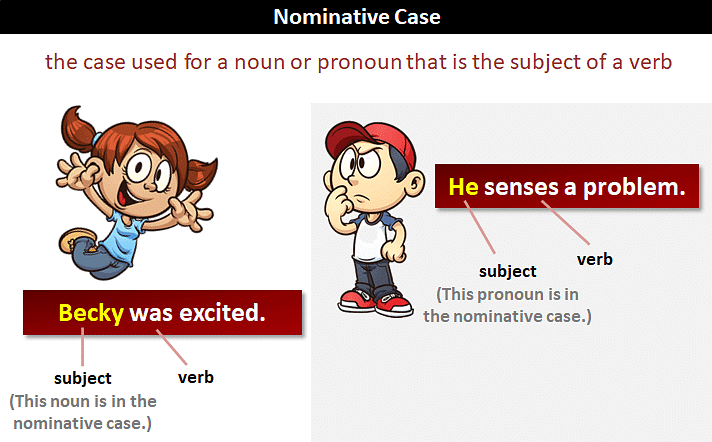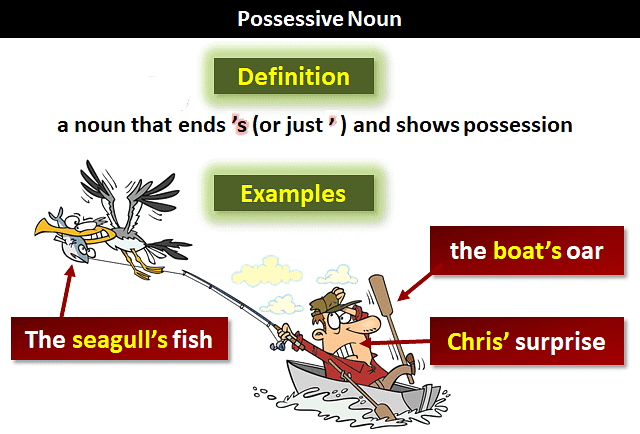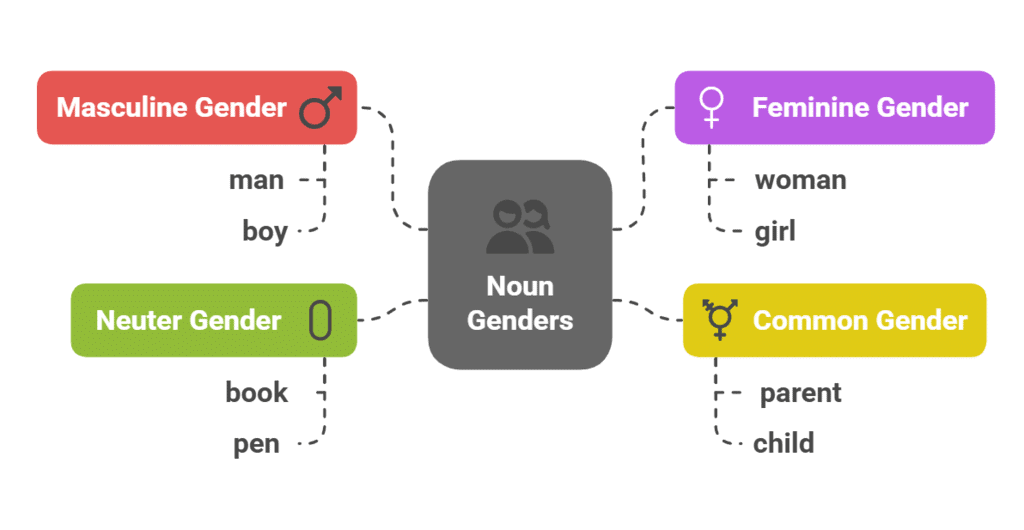Class 10 English Grammar - Noun its Classifications Part 2
| Table of contents |

|
| Noun: Case |

|
| Possessive Case |

|
| Noun: Gender |

|
| Gender in Expressive Language |

|
| Special Cases in Gender |

|
Noun: Case
Cases in nouns tell about the position and role of a noun in a sentence.
There are four kinds of cases:
- Nominative
- Accusative
- Possessive
- Dative

Let us discuss these cases in detail. Each noun case is made bold.
Nominative Case
If a noun or a pronoun is used as the subject, it is called nominative use.

For example,
She is reading.
↓
Nominative
Mohan is walking
↓
Nominative
Accusative Case
If a noun or pronoun is used as the object, called accusative use.
For example,
I like her.
↓
Accusative
That is Anjali.
↓
Accusative
Possessive Case
A possessive case shows the possession, ownership, or authority of a noun. That case shows a relationship between two nouns or between a noun and a pronoun.

For example,
Rahul's book.
↓
possession
Sharukh's brother.
↓
relation
Rules to write possessive cases:
- At the end of a singular noun we put —'s for possessive case :
For example,
Rajiv's book, Meena's mother, President's bodyguard. - —s ending plural nouns take only (’):
For example
Boys' hostel, Girls' school
But,
Women's college, Men's competition, Children's park
3. In compound nouns, we use possessive with the last term:
For example,
1. Commander-in-chief's order
2. Mother-in-law's house
3. Father-in-law's problem
4. Engineer-in-chiefs' office
5. Brother-in-law's wife.
4. If possessive is used before than, it should be used after than:
For example,
1. Ravi's sister is more beautiful than Karan. —wrong
Ravi's sister is more beautiful than Karan's. —correct.
2. Kareena's husband is more handsome than Karishma. — wrong
Kareena's husband is more handsome than Karishma's. — correct
3. Rohan's brother is more intelligent than Mohan. —wrong
Rohan's brother is more intelligent than Mohan's. —correct
Dative Case
A noun is said to be in a dative case if it is the Indirect object of the verb. (Indirect object of the verb is the noun for whom or for which the action of the verb is carried out). There should not be a preposition before the indirect object because in that case, it will be the object of that preposition. For example,
Get him a pen
↓
Dative
The postman brought me a letter.
↓
Dative
Noun: Gender
What is Gender?
In grammar, gender refers to the classification of nouns and pronouns based on sex or characteristics. The word "gender" comes from the Latin genus, meaning "kind" or "sort."
Living beings are classified as either male or female, and nouns associated with them follow this categorization. Additionally, some nouns refer to objects or concepts that do not have a specific gender.
Types of Gender in Nouns
Masculine Gender
A noun that refers to a male being is classified as masculine gender.
Examples: man, boy, king, father, lion, bull, horse.Feminine Gender
A noun that refers to a female being is classified as feminine gender.
Examples: woman, girl, queen, mother, lioness, cow, mare.Common Gender
Some nouns can be used for both males and females. These belong to the common gender category.
Examples: parent, child, pupil, servant, friend, thief, relation, enemy, cousin, orphan, student, person, baby, guardian, monarch, infant, neighbour, tutor.Neuter Gender
A noun that represents an object without life and does not fall into the categories of masculine or feminine gender is classified as neuter gender.
Examples: book, pen, table, chair, room, wall, tree, paper, ball, sword, radio, telephone, bag, cloth, cigarette, music, key, bus, auto, motor, song.

Gender in Expressive Language
In literary and poetic expressions, certain objects and abstract concepts are personified and assigned a gender based on their characteristics.
Masculine gender is often associated with strength, power, and dominance.
Examples: death, time, winter, summer, the sun, fear, love.Feminine gender is linked to beauty, gentleness, grace, fertility, and emotions.
Examples: the moon, the earth, spring, liberty, autumn, nature, charity, church, hope, justice, mercy, peace, religion, truth, virtue. Additionally, names of countries, locomotive engines, cars, ships, and branches of arts and sciences are often considered feminine.
Special Cases in Gender
Some nouns do not strictly follow the gender rules and have unique classifications.
Masculine nouns used in the common gender:
Certain masculine nouns are commonly used for both men and women.
Examples: actor, advocate, author, chairman, doctor, hound, lawyer, man, painter, poet, teacher, tutor, hunter.Feminine nouns used in the common gender:
Some feminine nouns are used for both males and females.
Examples: cow, duck, bee.Feminine nouns with no masculine equivalent:
Some feminine nouns do not have a corresponding masculine form.
Examples:Housewife – Mistress of the house
Virgin – An unmarried woman
Flirt – A woman pretending to make love
Virago – A turbulent or strong-willed woman
Dowager – A widow who possesses her late husband's property
Siren – An enticing or seductive woman
Brunette – A dark-complexioned woman
Prude – A woman with an exaggerated sense of modesty
Masculine nouns with no feminine equivalent:
Some masculine nouns do not have a corresponding feminine form.
Examples: captain, judge, knight, squire, parson.
|
20 videos|143 docs|18 tests
|
FAQs on Class 10 English Grammar - Noun its Classifications Part 2
| 1. What is the definition of 'case' in English grammar? |  |
| 2. What are the different types of noun cases? |  |
| 3. How does gender classification in nouns work? |  |
| 4. Why is understanding noun cases and gender important in English grammar? |  |
| 5. Can you provide examples of nouns in different cases and genders? |  |
















